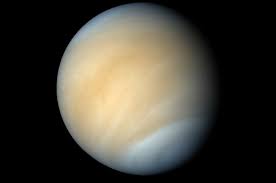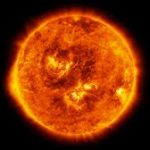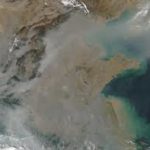Planet Venus – Twin of Planet Earth
Venus is second planet in the solar system and the closest neighbor of Earth. In size and structure, Venus resembles Earth and therefore, it is often described as Earth’s twin. But, compared to Venus, Earth is slightly bigger and differs in many aspects.
Features of Venus
Venus is the brightest object after the Sun and Moon as its atmosphere reflects sunlight. Due to the brightness, the planet earned the name Venus, name of the Roman goddess of beauty and love. The period of rotation of Venus is the longest in the solar system. Unlike other planets (except Uranus), it spins on its axis in the opposite direction of its revolution; it spins slowly in the clockwise direction. Venus takes about 243 earth days to complete one rotation where as it takes only 225 earth days to revolve round the Sun. This means that a day on Venus is longer than a year. Therefore, the Sun rises barely two times a year on Venus. Further, since the planet rotates backwards, the sun rises in the west and sets in the east.
Like Earth, Venus consists of mountains, volcanos and highland regions. It is radically different from earth in many other respects. The surface temperature of the planet is nine times hotter compared to Earth. It is the hottest planet in the solar system with temperature of about 480 degree Celsius. The densest atmosphere among the four terrestrial planets is that of Venus. The chief component of the atmosphere of Venus is carbon dioxide, consisting of more than 96%, along with small quantities of carbon monoxide, water vapour, nitrogen etc. Thick clouds of sulphuric acid envelop the surface of Venus and sometimes fall as rain. Many researchers believe that water once existed on the surface of Venus. However, extreme temperature and acidic clouds make it an unlikely place for life.
The atmospheric pressure is 90 times that of the Earth. The inner semi-solid core consists of iron and nickel. It has a diameter of 6000 kilometers. The rocky mantle has a thickness of 3,000 kilometers and the silicate crust is about 50 kilometers thick.
Appearance of Venus
Though Venus is the second planet after Mercury, it is the hottest among all planets. The thick atmosphere of Venus comprising of greenhouse gas, carbon dioxide and clouds of sulphuric acid traps heat and keeps the atmosphere extremely hot. The sky of Venus is yellow and cloudy and the surface is covered with thousands of volcanos many of which are still active with pools of lave flowing out. Unlike Mercury, no craters are found on the surface of Venus and scientists believe that volcanic eruptions might have covered up traces of collisions Venus had with meteors.
Exploration of Venus
Planet Venus was a prime target of exploration because of its proximity to Earth. It was the first planet beyond Earth to be visited by a space craft and the first to be successfully landed on. The first robotic space probe mission to any planet started with the Soviet Union’s Venera programme in 1961 with Venus as the destination. Venera-2 and Venera-3, discovered Venus in 1966. Venera-4 entered the atmosphere of Venus on 18 October 1967 and conducted scientific experiments. Venera-7 landed on the planet in 1970. US spacecraft Mariner-10 sent close photographs of Venus. Pioneer Venus -1 and 2 reached the planet and measured the atmospheric density and chemical composition in 1978. Japanese spacecraft, Akatsuki, launched in 2010 still orbits the planet. Venus is also being studied by Roscomos, NASA and ISRO.
The Sun – Origination, Life and Death
GSLV Mark III Launcher and GSAT -29 Satellite









